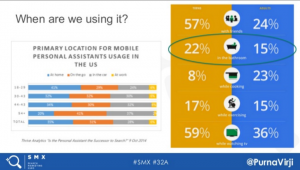Learn How to Optimize for Voice Search NOW: More than Half of Queries will be Voice Search Queries by 2020 was originally published on BruceClay.com, home of expert search engine optimization tips.
By 2020, there will be 200 billion voice search queries per month and more than half of searches will come from voice search, according to comScore research. Digital marketers need to invest in strategies that target voice searchers. Read on to get tips on optimizing for voice search with perspectives from a search agency (with Bing’s Purna Virji), a publisher (The SEM Post’s Jennifer Slegg) and an SEO (Elite SEM’s Tony Edward).

From left: Tony Edward, Purna Virji, Jennifer Slegg
Bing’s Purna Virji on the Evolution of Voice Search
Purna Virji, the senior training manager at Microsoft, talked about how voice search is shaping our world. Everything from television remotes to hotel rooms can be powered by voice. By 2017, all Ford vehicles will come with Apple CarPlay.
Reasons People Use Voice Search
- It’s faster than typing. You can speak 110–150 words per minute, as opposed to the average person’s typing rate of 38–40 words per minute.
You can speak 110–150 words per min, as opposed to avg person’s typing 38–40 wpm. -@purnavirji…
Click To Tweet - People want quick answers.
- People are often second screening or otherwise occupied
Jennifer Slegg: Content for the Voice Search Generation
Like Virji, the founder and editor of The SEM Post, Jennifer Slegg, believes the time to optimize for voice search is now.
Consider the fact that more than half of U.S. teens and 41% of adults use voice search on a daily basis, or that there are 30 times more action queries on voice search.
How Feature Snippets Work with Voice Search
Voice search has a higher percentage of featured snippets. Slegg says 43.3% for voice queries have featured snippets, compared to 40.6% for text queries. Moreover, Google reads the featured snippets aloud to users beginning with “According to (site)” or “We found this information on (site).” Google reinforces your brand in voice search. (Learn how to earn featured snippets in 2016.)
Use Moz and SEMRush to track your own and your competitors’ featured snippets.
RankBrain and Voice Search
- Stronger influence on 15% of search queries Google has never seen before, and they tend to be voice searches.
- You’re able to better rank conversational search queries with keywords.
- It’s the third most important ranking signal, behind content and links.
How do you optimize for RankBrain? By optimizing for conversational search.
How to Optimize for Voice Search
Voice search queries are longer than text search queries. The average query length for voice is 4.2 words, and the average query length for text is 3.2 words.
Long-tail queries are less competitive and have higher intent. While they’re searched for less, they’re more likely to convert.
Use your content to answer questions. There is a 61% growth in queries starting with who, what, where and how. Furthermore, almost 10% of voice search queries start with who, what, when, where, why, how – as opposed to only 3.7% of text queries. “How” begins 3.6% of all voice search queries and “What” begins 3.5% of all voice search queries.
Tony Edward on How Humans Speak
Tony Edward, the senior SEO manager at Elite SEM, reminded digital marketers that optimizing for voice search begins with standard SEO best practices.
- Build in-depth content that answers commonly asked questions around your brand, services, products, etc., including content that answers who, what, when, where, why and how.
- Leverage Structured Data Markup depending on the content type.
- Work to get your brand in the Knowledge Graph.
- Ensure content is structured well using headers and bulleted or numbered lists.
Edward shared his tips on coming up with content strategy:
- Mine call center, live chat and email data to find commonly asked questions surrounding your product, service or brand.
- Use third-party tools to get auto search suggestion topics, such as AnswerThePublic.com or UberSuggest.io.
By implementing the above best practices and creating useful content, Edward has been able to earn branded Knowledge Graphs and Featured Snippets. As noted earlier, getting a branded Knowledge Graph entry or Featured Snippet makes your result more voice search ready.

No comments:
Post a Comment